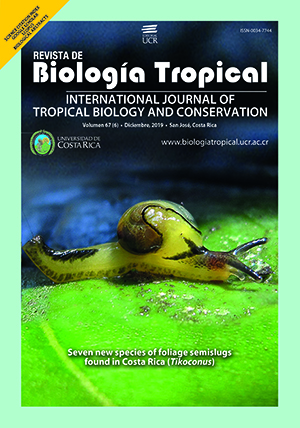Abstract
Abstract. Ontogenia y aspectos histoquímicos de los esporangios y escamas receptáculares del helecho epífito Pleopeltis macrocarpa (Polypodiaceae). Ontogeny and histochemical aspects of sporangia and receptacular scales of the epiphytic fern Pleopeltis macrocarpa (Polypodiaceae). Introduction: The ontogeny of sporangia and furthermore the structure and function of the receptacular scales showed by the sori of some fern species are topics scarcely represented in the scientific literature. Objectives: To describe and analyze the ontogeny of sporangia and receptacular scales of Pleopeltis macrocarpa. Methods: During the months March and April of 2017, fertile fronds of P. macrocarpa were collected from tree stems located in the plant nursery “El Edén de las flores”, municipality of Rionegro, Antioquia, Colombia. The samples were fixed and processed according to the standard protocols for embedding and sectioning in paraffin and resin. Sections obtained in resin (0.5µm) were stained with Toluidine blue. The additional descriptions of the anatomy and histochemistry required specific reagents, applied for the determination of primary walls, secondary walls, nuclei, lignin, polyphenols, polysaccharides, pectic substances and cellulose. The observations and photographic records were performed by photonic and epifluorescence microscopy. For the scanning electron microscopy (SEM) technique, the sori were dehydrated with 2,2- Dimethoxypropane, dried to critical point and coated with gold. Results: The sori are superficial, vascularized and have mixed development, covered by receptacular scales that detach as the sporangia reaches maturity. The leptosporangiate type sporangium have long stalks of primary walls, the annulus of the sporangia show secondary walls with “U” shaped thickenings rich in lignin. The epidermal cells of the receptacles originate the sporangia and receptacular scales. The mitotic division events of these two structures are initially similar, but then diverge for the reproductive and vegetative differentiation of these two organs. Meiosis is simultaneous and the spore tetrads are arranged in a decussate or tetragonal shape. The cellular tapetum is initially unstratified but becomes bistratified by mitotic division. The inner layer of the tapetum cells break originating a plasmodial tapetum. During the sporoderm development, the first structure formed is the exosporium, composed of sporopolenin, followed by the endosporium composed of cellulose, pectin and carboxilated polysaccharides, and finally the perisporium. The histochemistry and epifluorescence results indicate that both the sporangia and immature receptacular scales have cell walls of cellulosic. These structures as well as those of the sporangium wall cells maintain its composition during maturation. Whereas, the epidermal wall cells of the shields from the mature receptacular scales are characterized by thickened cuticle. The polyphenols are present during all the development stages of the sporangia and receptacular scales. Starch is abundant in the early stages of development of the receptacle cells and sporangial primordia. Conclusions: The ontogeny of the sporangia of P. macrocarpa is similar to the described for leptosporangiate ferns. The receptacular scales are mainly protective structures, its morphology and cell wall composition prevent dessication or humidity loss of the sporangia during the labile stages of development. These results agree with the protective function attributed to the peltate pluricellular scales present in the vegetative structures of drought tolerant species of ferns and angiosperms.
##plugins.facebook.comentarios##

This work is licensed under a Creative Commons Attribution 4.0 International License.
Copyright (c) 2019 Edgar Javier Rincón Barón, Beatriz Elena Guerra Sierra, David Esteban Restrepo Zuluaga, Silvia Espinosa Matías






